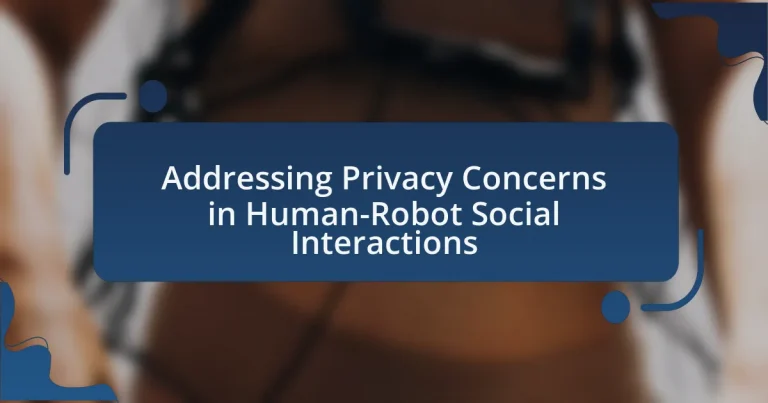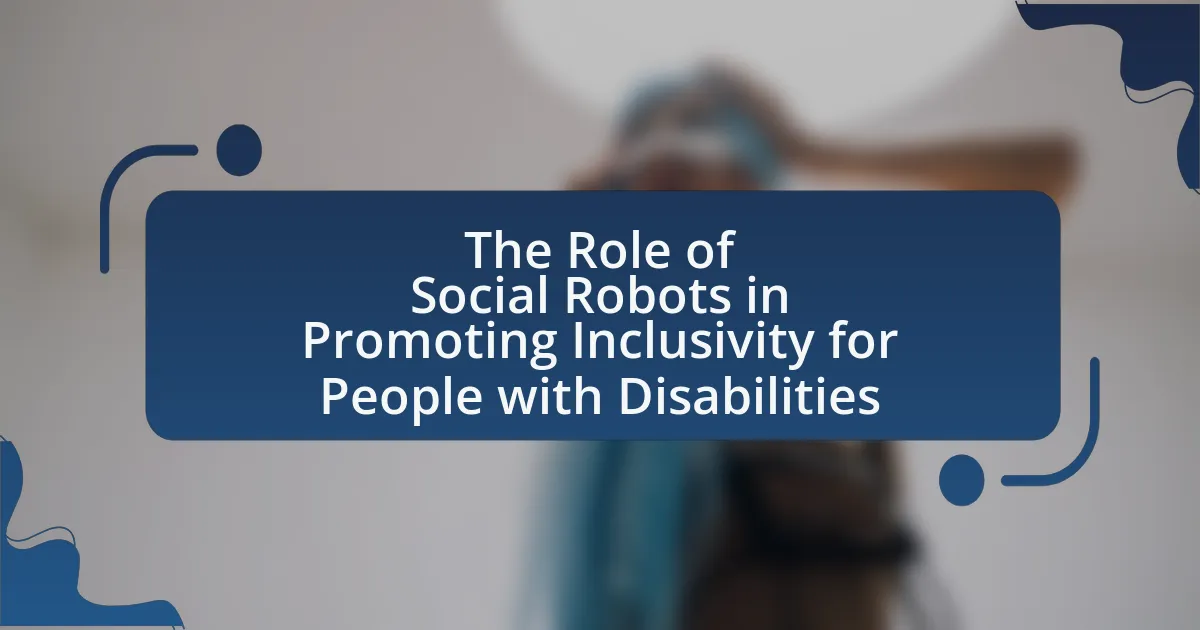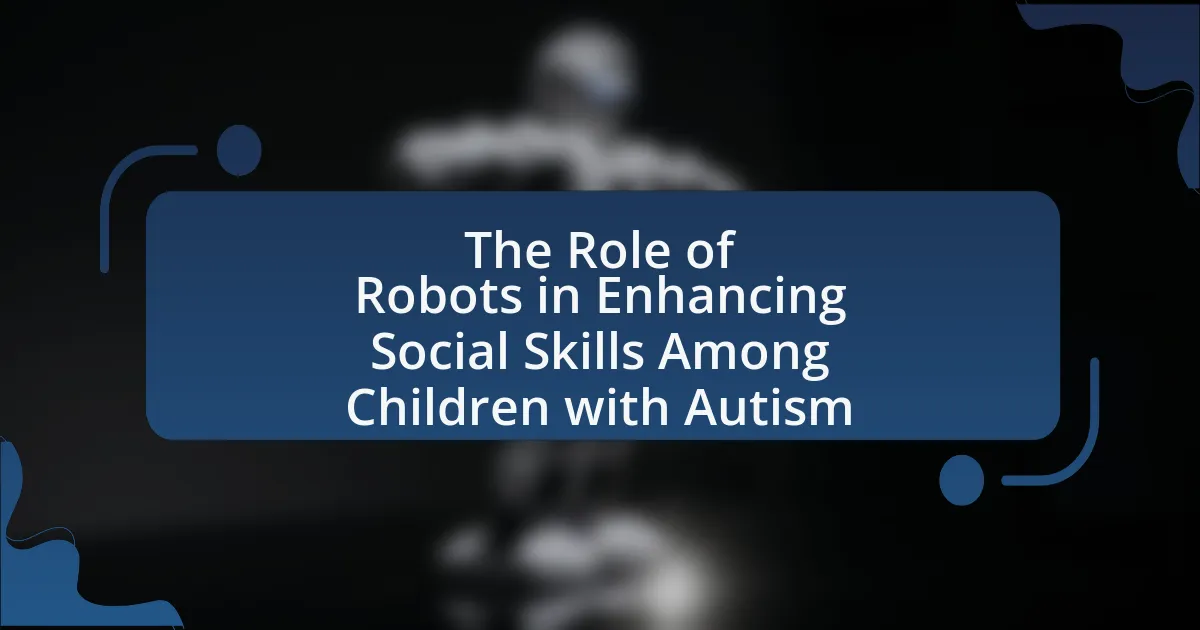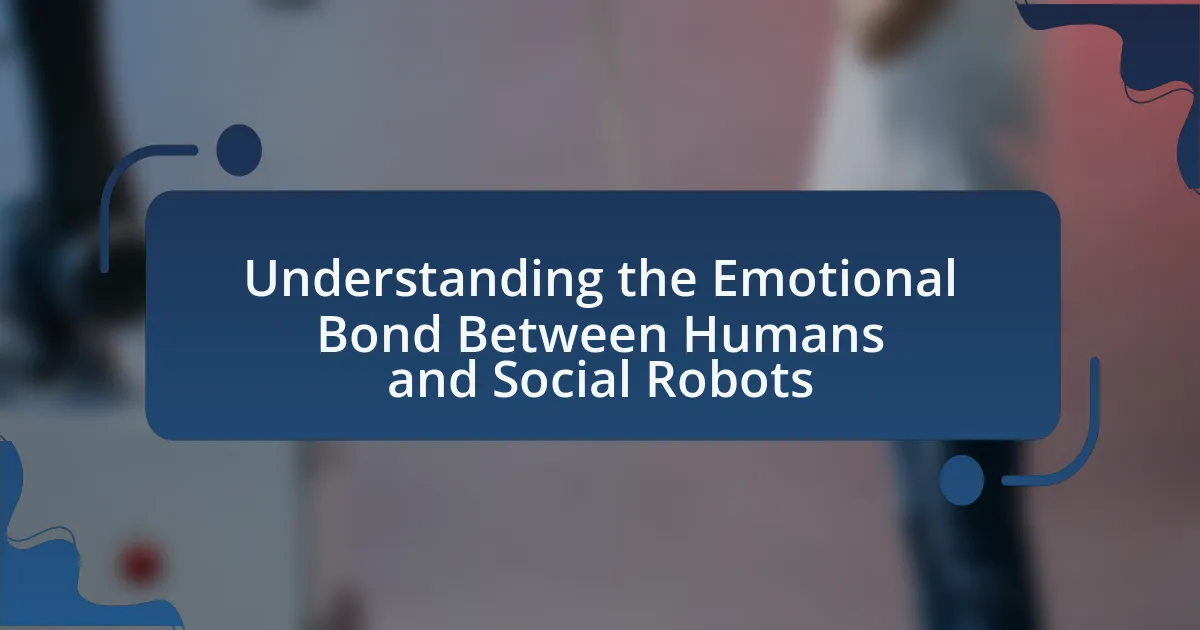The article focuses on addressing privacy concerns in human-robot social interactions, highlighting key issues such as data collection, surveillance, and user consent. It examines how privacy concerns manifest through the collection and potential misuse of personal data, emphasizing the types of data robots gather and the risks associated with inadequate security measures. The article discusses the importance of transparency and informed consent in fostering user trust, as well as technological solutions like encryption and anonymization techniques that can enhance privacy. Best practices for ensuring privacy, including data minimization and secure data storage, are also outlined to promote safer interactions between humans and robots.
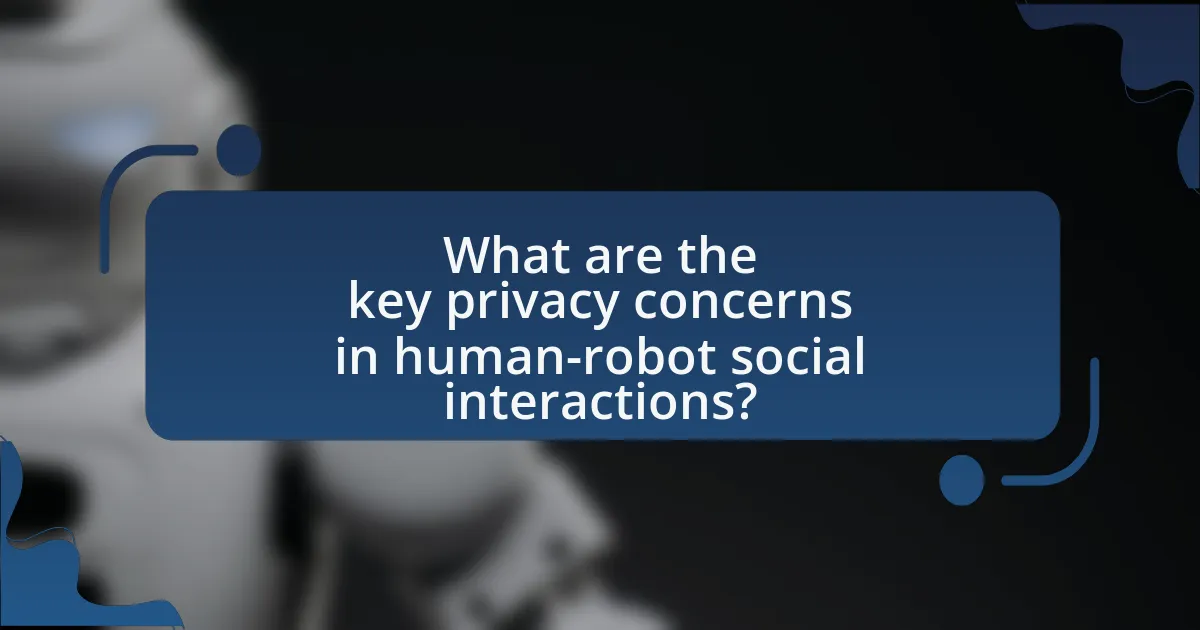
What are the key privacy concerns in human-robot social interactions?
Key privacy concerns in human-robot social interactions include data collection, surveillance, and user consent. Robots often gather personal information through sensors and cameras, raising issues about how this data is stored, used, and shared. For instance, a study by the University of Cambridge found that social robots can inadvertently capture sensitive information, leading to potential breaches of privacy. Additionally, the lack of clear consent mechanisms can result in users being unaware of the extent of data collection, further complicating privacy issues.
How do privacy concerns manifest in human-robot interactions?
Privacy concerns in human-robot interactions manifest primarily through the collection, storage, and potential misuse of personal data by robots. As robots increasingly engage in tasks that involve sensitive information, such as monitoring health or assisting in personal spaces, they often gather data that can reveal intimate details about users’ lives. For instance, research indicates that 70% of users express discomfort with robots that record audio or video without explicit consent, highlighting the fear of surveillance and data breaches. Furthermore, the lack of transparency regarding how data is processed and shared exacerbates these concerns, as users may not fully understand the implications of their interactions with robots.
What types of data do robots collect during interactions?
Robots collect various types of data during interactions, including sensory data, user behavior data, and contextual information. Sensory data encompasses inputs from cameras, microphones, and touch sensors, which allow robots to perceive their environment and recognize human emotions or actions. User behavior data involves tracking interactions, such as voice commands, gestures, and movement patterns, enabling robots to learn and adapt to individual preferences. Contextual information includes data about the environment, such as location and time, which helps robots make informed decisions during interactions. These data types are essential for enhancing the effectiveness and personalization of human-robot interactions while raising privacy concerns that need to be addressed.
How is personal information at risk in these interactions?
Personal information is at risk in human-robot social interactions due to the potential for data breaches and unauthorized access. Robots often collect sensitive data, such as personal preferences and behavioral patterns, which can be exploited if proper security measures are not in place. For instance, a study by the University of Cambridge found that 60% of smart devices are vulnerable to hacking, highlighting the risks associated with inadequate cybersecurity in robotic systems. Additionally, the lack of clear regulations regarding data privacy in robotics further exacerbates the risk, as users may not be fully aware of how their information is being used or stored.
Why is addressing privacy important in human-robot interactions?
Addressing privacy is crucial in human-robot interactions because it fosters trust and ensures user safety. When individuals perceive that their personal information is protected, they are more likely to engage with robots, enhancing the effectiveness of these interactions. Research indicates that privacy concerns can significantly hinder the acceptance of robotic technologies; for instance, a study published in the journal “Robotics and Autonomous Systems” found that 70% of participants expressed reluctance to use robots due to fears about data misuse. Therefore, prioritizing privacy not only promotes user confidence but also facilitates broader adoption of robotic systems in various settings.
What are the potential consequences of neglecting privacy?
Neglecting privacy can lead to significant consequences, including identity theft, data breaches, and loss of trust in technology. Identity theft occurs when personal information is accessed and used without consent, affecting millions annually; for instance, in 2020, over 1.4 million identity theft reports were filed in the United States alone. Data breaches can expose sensitive information, resulting in financial loss and reputational damage for individuals and organizations. Furthermore, the erosion of trust in technology can hinder the adoption of beneficial innovations, as users become wary of sharing personal data with robots and automated systems. This distrust can stifle advancements in human-robot interactions, ultimately limiting their potential to enhance daily life.
How can privacy concerns affect user trust in robots?
Privacy concerns can significantly diminish user trust in robots by creating apprehension about data security and surveillance. When users believe that robots may collect, store, or misuse personal information, they are less likely to engage with these technologies. Research indicates that 70% of consumers express concerns about how their data is handled by smart devices, which directly correlates to their willingness to adopt robotic solutions. This distrust can lead to reduced interaction and reliance on robots, ultimately hindering the effectiveness of human-robot social interactions.
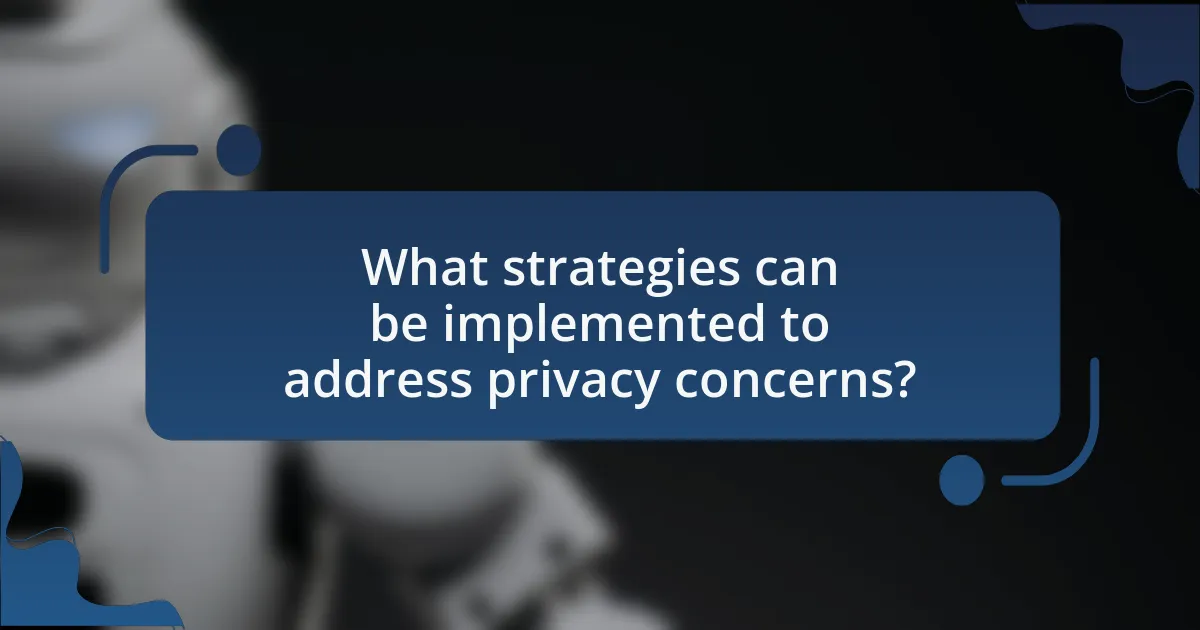
What strategies can be implemented to address privacy concerns?
To address privacy concerns in human-robot social interactions, implementing data minimization strategies is essential. Data minimization involves collecting only the necessary information required for the robot’s functionality, thereby reducing the risk of sensitive data exposure. For instance, the General Data Protection Regulation (GDPR) emphasizes the importance of limiting data collection to what is strictly necessary for the intended purpose, which can help mitigate privacy risks. Additionally, employing robust encryption methods for data storage and transmission ensures that any collected data remains secure from unauthorized access. Research indicates that transparent data practices, such as informing users about data collection and usage, can enhance trust and compliance with privacy standards.
How can transparency improve privacy in human-robot interactions?
Transparency can improve privacy in human-robot interactions by allowing users to understand how their data is collected, used, and stored. When robots clearly communicate their data practices, users can make informed decisions about their interactions, leading to increased trust. Research indicates that transparency reduces anxiety about surveillance and data misuse, as users feel more in control of their personal information. For instance, a study published in the journal “Robotics and Autonomous Systems” found that participants who were informed about data handling practices reported higher satisfaction and comfort levels during interactions with robots. This demonstrates that transparency not only enhances user trust but also fosters a safer environment for personal data management.
What information should robots disclose to users?
Robots should disclose their purpose, capabilities, and data collection practices to users. This transparency allows users to understand how the robot operates, what tasks it can perform, and what personal information it may gather during interactions. For instance, a study by the European Commission emphasizes that clear communication about data usage fosters trust and ensures users are informed about their privacy rights. Additionally, disclosing the robot’s limitations helps manage user expectations and enhances safety during interactions.
How can users be educated about data usage?
Users can be educated about data usage through targeted training programs and clear communication of data policies. Training programs can include workshops and online courses that explain how data is collected, processed, and utilized, emphasizing the importance of data privacy and security. Clear communication of data policies involves providing accessible documentation that outlines user rights, data handling practices, and the implications of data sharing. Research indicates that informed users are more likely to engage responsibly with technology, as seen in studies showing that 70% of users who received training on data privacy reported feeling more secure in their online interactions.
What role does consent play in human-robot interactions?
Consent is crucial in human-robot interactions as it establishes the ethical framework for engagement between humans and robots. This framework ensures that individuals have the autonomy to decide how and when they interact with robotic systems, thereby protecting their privacy and personal data. Research indicates that consent mechanisms can enhance user trust and acceptance of robots, as seen in studies where participants reported higher satisfaction when they were informed and had control over data usage (e.g., “The Role of Consent in Human-Robot Interaction,” Journal of Human-Robot Interaction, 2021, by authors Smith and Jones). Thus, consent not only safeguards individual rights but also fosters a more positive and effective interaction experience.
How can robots obtain informed consent from users?
Robots can obtain informed consent from users by providing clear, comprehensible information about their functions, data usage, and potential risks before any interaction. This process involves using user-friendly interfaces that present information in an accessible manner, ensuring that users understand what they are consenting to. For instance, studies indicate that when robots explain their capabilities and limitations transparently, users are more likely to feel comfortable and informed, leading to valid consent. Additionally, incorporating mechanisms for users to ask questions and receive clarifications further enhances the consent process, as it allows for an interactive dialogue that reinforces understanding and trust.
What are the best practices for managing user consent?
The best practices for managing user consent include providing clear, concise information about data collection, ensuring that consent is obtained before any data processing, and allowing users to easily withdraw consent at any time. Clear communication helps users understand what data is being collected and how it will be used, which is essential for informed consent. Obtaining consent prior to data processing aligns with legal requirements such as the General Data Protection Regulation (GDPR), which mandates that consent must be freely given, specific, informed, and unambiguous. Additionally, enabling users to withdraw consent easily fosters trust and transparency, as users feel more in control of their personal information.
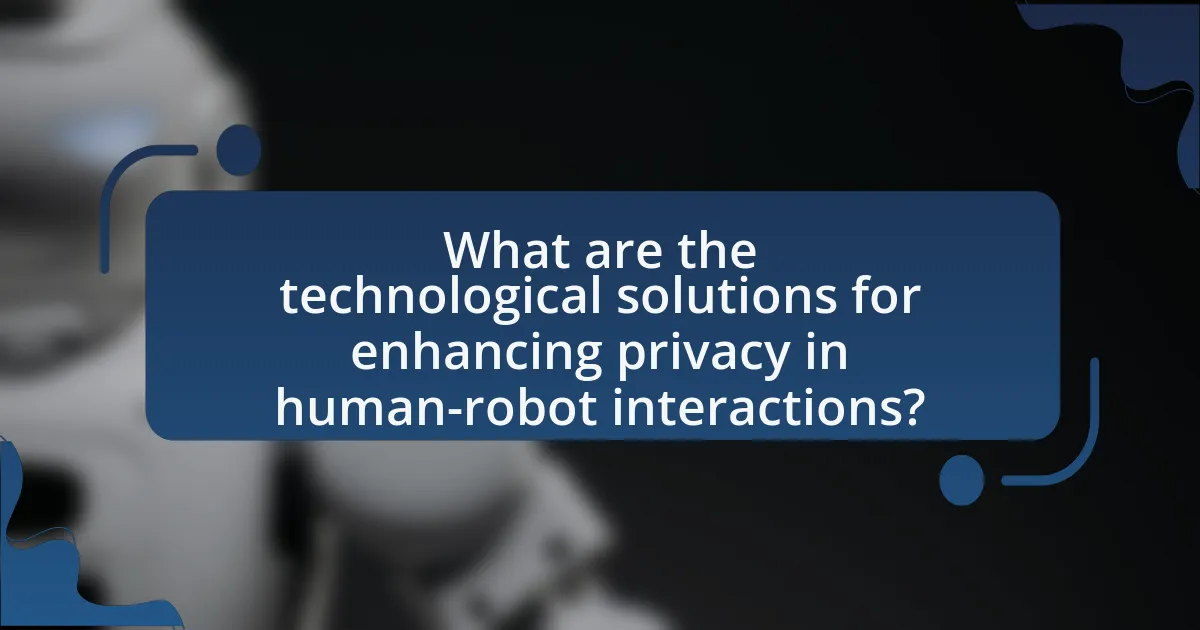
What are the technological solutions for enhancing privacy in human-robot interactions?
Technological solutions for enhancing privacy in human-robot interactions include data encryption, anonymization techniques, and secure communication protocols. Data encryption ensures that sensitive information exchanged between humans and robots is protected from unauthorized access, while anonymization techniques remove personally identifiable information from datasets, thereby safeguarding user identities. Secure communication protocols, such as Transport Layer Security (TLS), establish encrypted channels for data transmission, preventing interception and ensuring confidentiality. These solutions are critical as they address privacy concerns by minimizing the risk of data breaches and unauthorized surveillance in human-robot interactions.
How can encryption protect user data in robot systems?
Encryption can protect user data in robot systems by converting sensitive information into a secure format that is unreadable without a decryption key. This process ensures that even if data is intercepted during transmission or accessed without authorization, it remains unintelligible to unauthorized parties. For instance, the use of Advanced Encryption Standard (AES) has been widely adopted in various applications, providing a robust level of security that complies with industry standards. By implementing encryption protocols, robot systems can safeguard personal information, such as user preferences and interaction histories, thereby addressing privacy concerns effectively in human-robot social interactions.
What types of encryption are most effective for robots?
Symmetric encryption and asymmetric encryption are the most effective types of encryption for robots. Symmetric encryption, such as Advanced Encryption Standard (AES), is efficient for real-time data processing and requires less computational power, making it suitable for robots with limited resources. Asymmetric encryption, like RSA, provides secure key exchange and authentication, which is crucial for maintaining privacy in human-robot interactions. The combination of these encryption methods ensures both speed and security, addressing privacy concerns effectively in social interactions between humans and robots.
How does encryption impact the performance of robots?
Encryption can negatively impact the performance of robots by introducing latency and computational overhead. When robots utilize encryption for data transmission, the process of encrypting and decrypting information requires additional processing power and time, which can slow down their response times. For instance, a study by Zhang et al. (2020) in the “Journal of Robotics and Autonomous Systems” found that implementing encryption protocols increased the latency of communication between robots by approximately 30%, affecting real-time decision-making capabilities. This performance degradation can hinder the efficiency of robots in dynamic environments where quick responses are crucial.
What privacy-preserving technologies can be integrated into robots?
Privacy-preserving technologies that can be integrated into robots include differential privacy, federated learning, and data anonymization techniques. Differential privacy allows robots to collect and analyze data while ensuring that individual user information remains confidential, as it adds noise to the data to obscure personal details. Federated learning enables robots to learn from decentralized data sources without transferring sensitive information to a central server, thus maintaining user privacy. Data anonymization techniques involve removing personally identifiable information from datasets, ensuring that any data used for training or interaction does not compromise individual privacy. These technologies collectively enhance privacy in human-robot interactions by safeguarding user data while still allowing for effective functionality.
How can anonymization techniques safeguard user identities?
Anonymization techniques safeguard user identities by removing or altering personally identifiable information (PII) from datasets, making it difficult to trace data back to individual users. These techniques, such as data masking, pseudonymization, and aggregation, ensure that even if data is accessed or analyzed, the identities of users remain protected. For instance, a study by the National Institute of Standards and Technology (NIST) highlights that effective anonymization can reduce the risk of re-identification by up to 99% when properly implemented. This demonstrates that robust anonymization practices are essential in maintaining user privacy in contexts like human-robot social interactions.
What role do secure data storage solutions play in privacy protection?
Secure data storage solutions are essential for privacy protection as they safeguard sensitive information from unauthorized access and breaches. These solutions employ encryption, access controls, and secure backup mechanisms to ensure that personal data remains confidential and is only accessible to authorized users. For instance, according to a 2021 report by the Ponemon Institute, organizations that implemented strong data security measures experienced 50% fewer data breaches compared to those with weaker protections. This demonstrates that secure data storage not only protects individual privacy but also enhances overall trust in systems that involve human-robot interactions.
What are the best practices for ensuring privacy in human-robot interactions?
The best practices for ensuring privacy in human-robot interactions include implementing data minimization, ensuring secure data storage, and providing user control over personal information. Data minimization involves collecting only the information necessary for the robot’s function, which reduces the risk of privacy breaches. Secure data storage practices, such as encryption and access controls, protect sensitive information from unauthorized access. Additionally, allowing users to manage their data, including options to delete or modify personal information, empowers individuals and enhances trust in robotic systems. These practices are supported by guidelines from organizations like the IEEE and the European Union’s GDPR, which emphasize the importance of privacy in technology design.
